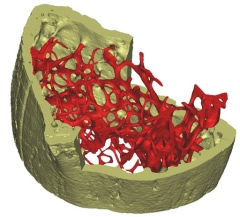Materialise Releases Mimics 12 for Medical Solutions
New module serving cardiovascular and pneumology research, enables easy pore analysis.
Latest News
June 27, 2008
By DE Editors
 Trabecular bone as a porous structure, prepared for analysis by the new module. |
Materialise (Leuven, Belgium) has released Mimics 12 for tissue engineers who are working on scaffolds, foams, trabecular bone, and other porous structures. Included in Mimics 12 is a complete new pore analysis module that lets you characterize porous structures and analyze them effortlessly and quickly.
Measurements like pore diameter distribution, chamber pore size distribution, and interconnectivity are graphically visualized and can be exported for further (statistical) analysis.
Designed to serve cardiovascular and respiratory research, Mimics 12 offers interactive centerline measurements, due to the implementation of advanced algorithms. You can perform and interpret the centerline measurements directly in 3D, making the centerline measurement tool even more powerful and saving you a lot of time.
Plus, CFD analyses typically require clearly defined inlet and outlet surfaces. Creating those on 3D models, of arteries or airways for example, has always been a delicate job. Due to the new centerline based cutting tool it is now easier and faster to cut the 3D model perpendicular to the centerline, thereby creating perfect inlet and outlet surfaces. Combined with the existing surface-preserving remeshing, this will allow for a fluent workflow towards CFD analyses.
Mimics 12 is compatible with multi-phase images. During import, Mimics will recognize the different phases and allow you to import them as separate sequences. Plus, in Mimics 12 the wrap tool efficiently closes small holes in the 3D, smooths the object to the user defined level, and significantly improves the mesh. As a result, this tool can halve the time to create an optimized mesh. And image filters suppress noise easily, making segmentation straightforward.
To further simplify the segmentation process, the multiple slice edit was extended with an interpolation option. Also the dynamic region-growing algorithm was made faster and easier, allowing you to easily select a complete artery network, as one example.
For details, go to Materialise.
Sources: Press materials received from the company and additional information gleaned from the company’s website.
Subscribe to our FREE magazine, FREE email newsletters or both!
Latest News
About the Author
DE’s editors contribute news and new product announcements to Digital Engineering.
Press releases may be sent to them via [email protected].






